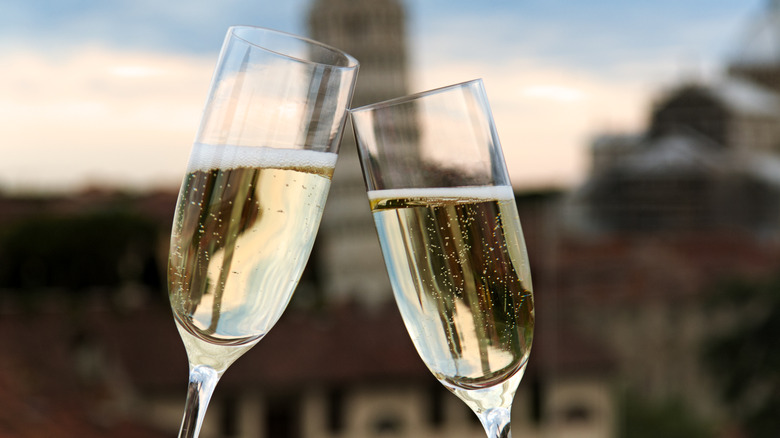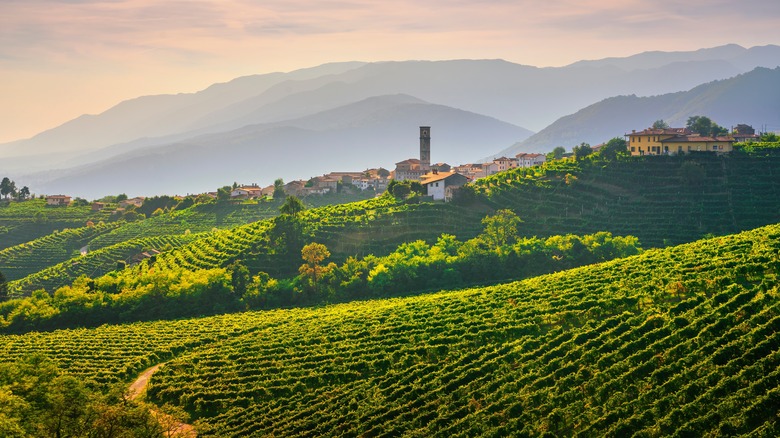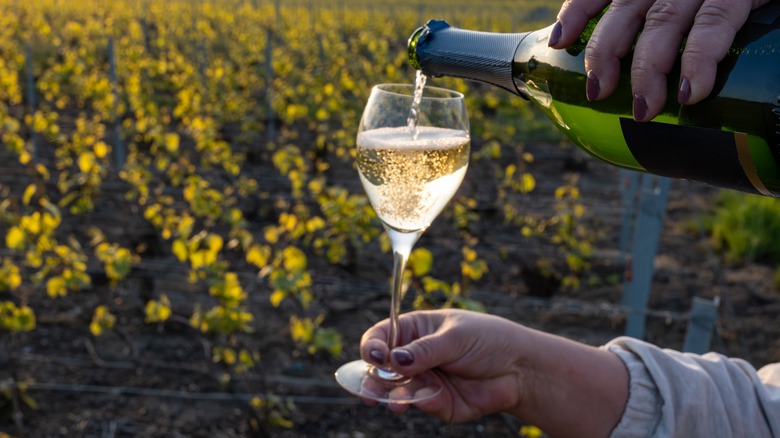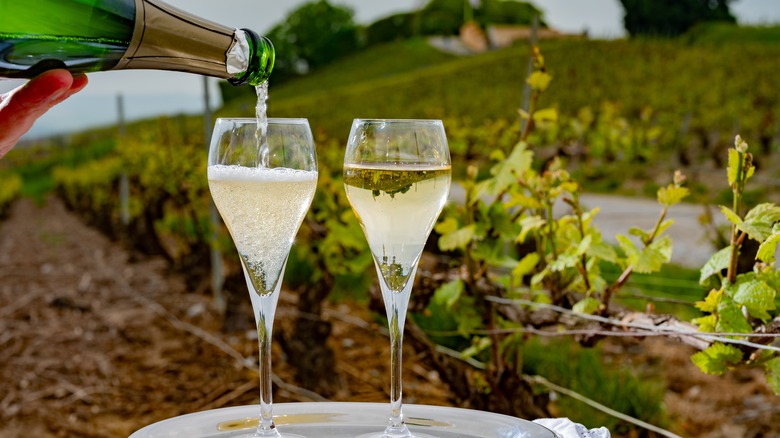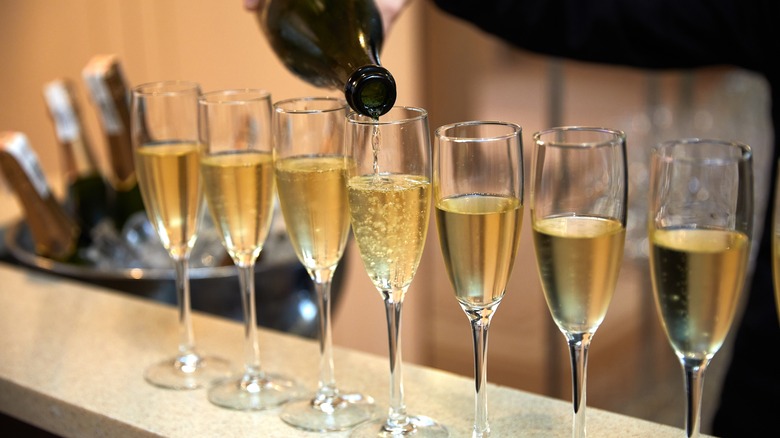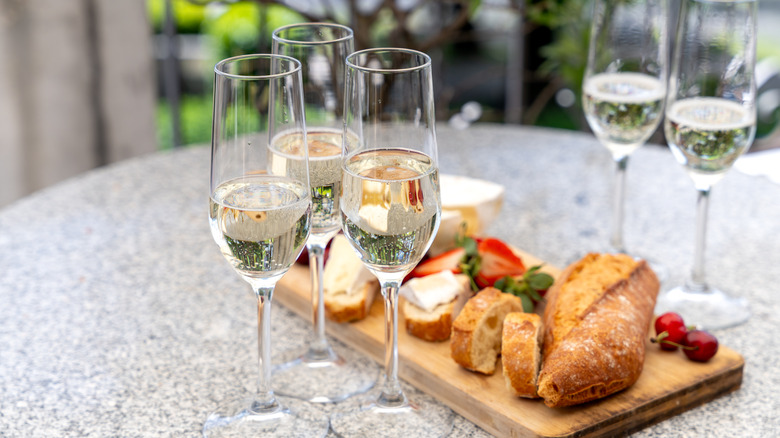Champagne Vs Prosecco: What's The Difference?
We may receive a commission on purchases made from links.
When the occasion calls for a bubbly beverage to celebrate, a bottle of chilled Champagne is passed around. Or wait — is it Prosecco? Or, is Prosecco what we drink during a long Sunday brunch? Both Champagne and Prosecco are sparkling white wines — but there are a few key differences between the two that set them apart as distinct wines.
The most simple way to understand the difference between these two wines is by the country they originate from: Champagne is French and Prosecco is Italian. This can be defined further by region; Champagne comes from the Champagne region of France, which lies in the northeast part of the country. Prosecco can come from two different wine-growing regions – Veneto and Friuli Venezia Giulia — that encompass nine different provinces in northeastern Italy; there is also a village called Prosecco in the province of Trieste (near the border of Slovenia) after which the wine is named.
Champagne is officially considered an older beverage, by more than 150 years. The first sparkling Champagne was produced by the famous Dom Pérignon in 1693 — however, the first French sparkling white wine was produced over 100 years earlier by monks in a different region of France in 1531. The first written record of Prosecco wine appears in 1772; however, it's possible that it was produced earlier. Historical records indicate that high-quality wine was produced in the same region in 1 A.D. — but there's no way of knowing if it's the sparkling Prosecco we have today.
Differences between the grapes and production
Each sparkling white wine uses a different grape. Prosecco originally used a grape named Prosecco, which was changed to the name Glera in recent years. This grape variety must make up 85% of the wine to be considered a Prosecco; the remaining 15% can be comprised of varietals like pinot bianco, pinot grigio, verdiso, perera, chardonnay, and bianchetta trevigiana.
Champagne can be made from several grape varieties, which includes quite a generous range, like chardonnay, pinot meunier, pinot noir, pinot blanc, pinot gris, petit meslier, and arbane. The sparkling French wine is slightly less strict than Prosecco because there are no defined percentages; it is permitted to be made from one of these varietals or a blend.
Each wine begins like any other wine — grapes are harvested and mashed, yeast is added to the grape juice, and then it goes through a first fermentation. The difference between the two occurs with the second fermentation. Prosecco's second fermentation is completed using a technique called the Charmat or tank method, where the wine is stored in closed tanks for about a month, sometimes up to nine months, to trap the carbon dioxide. Champagne's second fermentation — called traditional fermentation or méthode Champenoise — takes place inside the wine bottle for considerably longer, at least one year. When the Champagne is ready, the yeast is strained out of the bottle and then a small amount of sugar and wine must is added to the bottle to round it out.
Differences between flavor and bubbles
The second fermentation has a significant impact on the final flavor of each wine. A key difference here is that Champagne has longer contact with yeast as it sits in the bottle, while the yeast is filtered out before Prosecco is bottled. Yeast-influenced flavors — often found in beers such as Belgium dubbels and tripels — can be reminiscent of toast and baked goods. Outside of the bready notes, Champagne has a rather complex range of flavors, including stone fruits, dried fruits, nuts, strawberry, citrus, and even creamy notes.
Prosecco doesn't typically have these bread-like flavors, but rather more delicate ones. It's still a wine full of flavor, but floral, vanilla, citrus, pear, and apple tend to be the dominant notes. The Italian sparkling white wine can also have some nutty or creamy notes like Champagne, with hints of hazelnut and banana cream.
The bubbles also differ between the two sparkling wines. Prosecco has bigger bubbles that rise to the surface more quickly, creating an almost frothy mouthfeel. There are two distinct categories for the level of carbonation in Prosecco — spumante has the most carbonation, while semi-sparkling frizzante is flatter. The Prosecco bubbles tend to dissipate quicker than the Champagne bubbles, which are finer and more delicate, and last longer in the wine glass. Overall, Champagne is considered to be a more carbonated wine compared to Prosecco.
Levels of sweetness in the two sparkling wines
Whatever your wine preference is — dry or sweet — there is an appropriate Prosecco or Champagne for you. There's more to labeling wine as just sweet or dry — more specific subcategories exist within them. The sweetness levels of each type of wine are determined by the grams of residual sugar per liter. The most popular style of Prosecco is that which has the lowest amount of residual sugar, called extra-dry, or brut. For something sweeter, go for dry or semi-dry (often labeled as demi-sec).
When it comes to Champagne, brut also is one of the most popular options for sweetness levels. It's possible to go even drier, with extra brut or brut nature. Like Prosecco, there's dry and semi-dry for slightly sweeter, but Champagne can go all the way up to doux, which is considered quite sweet and functions well as a dessert wine. This level of sweetness is possible with Prosecco, but not common.
Differences between price and occasion
There is a considerable price difference between the two sparkling white wines, with Champagne generally being the more expensive option. For a decent bottle of Champagne, expect to pay around $40, while a good bottle of Prosecco can be purchased for half the price, around $20. The pricing doesn't necessarily confirm that Champagne is the better wine — but more so reflects its production process and fermentation length, which contribute to this higher price tag. Champagne is fermented for much longer than Prosecco; plus, the process of killing and extracting yeast after bottling is a much more labor-intensive process.
It's inaccurate to say that Prosecco is a cheaper Champagne. Prosecco can be just as quality and enjoyable as Champagne, but with a conveniently lower price tag due to its shorter fermentation and less labor-intensive production. This is why Champagne is often popped during a celebratory occasion or holiday — its higher price tag makes it more popular for special occasions.
Prosecco is fine to serve on special occasions too — sparkling wine is always a festive and fun drink. The Italian sparkling wine might be better for serving large groups, especially on a budget. For brunch, Prosecco is often the better choice — the floral-forward flavors pair better with orange juice in mimosas, while the more complex flavors of Champagne, especially the aged ones, are better sipped on solo.
Serving and pairing Prosecco and Champagne
You know how the production, bubbles, flavor, and price differ between Prosecco and Champagne — you're basically an expert now. The last step is to understand how to best serve and pair these sparkling wines. Both wines should be served well chilled to enhance the flavor. The slender flute is the most commonly used glassware for Champagne and sparkling wine, but some winemakers and experts are not fans. The narrow shape does not allow the wine to breathe and fully express its complex flavors and aromas. Instead, a tulip-shaped glass with a narrow top but a wider bowl, like this Gabriel-Glas one, is sometimes preferred.
Champagne's best-known pairing is caviar — but more affordable seafood options like shellfish and any raw seafood are great pairings. Fried snacks and salty potato chips make for a tasty balance against the lightly sweet and bubbly wine. When it comes to food pairings, the wines aren't so different — Prosecco also pairs up nicely alongside these dishes and snacks. Pairing wine with spicy foods can be a mistake, but low ABV wines like Champagne and Prosecco are excellent with them. The bubbles and light sweetness are refreshing against the spice and help clear the palate.
Prosecco pairs nicely with Italian cheeses and cured meats — think burrata, mozzarella, parmesan, pecorino romano, prosciutto, and salami.The perfect beverage for an antipasti platter or a mozzarella-rich pizza is naturally Prosecco. Don't forget dessert — fruit-forward and citrusy desserts complement similar notes found in the sparkling wine. The acidity and carbonation of the wine can also help cut through rich, creamy tarts and puddings.
